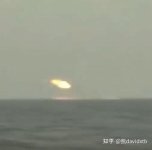Le ministère des Armées finance le développement de l’AASF, un missile antiradar destiné au Rafale
The French Ministry of Defence is funding the development of the AASF, an anti-radar missile for the Rafale fighter aircraft
by Laurent Lagneau -
18 October 2024
Last week, the future combat drone [UCAV] intended to accompany the Rafale upgraded to the F5 standard came under the spotlight, with the announcement by the Minister for the Armed Forces, Sébastien Lecornu, that contracts for its development had been awarded to Dassault Aviation, Thales and Safran.
This stealth combat drone will be equipped with new-generation sensors, ‘resilient’ connectivity and artificial intelligence algorithms. Capable of being refuelled in flight, it will have a ‘wide range of action’, according to the French Ministry of Defence. This means that its development will have to meet a number of technical challenges.
The Rafale F5 and this collaborative combat drone will have to operate the future ASN4G [Air Sol Nucléaire de 4e Génération] nuclear-capable missile. To do this, the pair
will have the ability to suppress and destroy enemy air defences [SEAD - Suppression of Enemy Air Defences]. This capability was lost by the French Air Force [AAE] with the withdrawal of the AS-37 MARTEL [Matra Anti-Radar TELévision] anti-radar missile at the end of the 1990s.
With the proliferation of A2/AD systems and the introduction of increasingly sophisticated air defence systems, the question of equipping the AAE with a Rafale dedicated to electronic warfare to jam enemy radars has been raised by a number of Members of Parliament with the Ministry of Defence.
But each time, the Ministry replied that it was not necessary to develop such an aircraft.
However, in a forward-looking document published in 2019, the AAE indicated that it wanted ‘to have weapons capable of neutralising enemy air defences as quickly as possible’, the aim being to guarantee its ability to ‘enter theatres of operations first’.
During the debates on the 2024-30 Military Planning Law [LPM], General Stéphane Mille, then Chief of Staff of the AAE, insisted on the recovery of this SEAD capability. ‘It is central to our future commitments: it will enable us to be much more at ease in increasingly contested environments, at a time when modern equipment will be diversifying around the world’, he explained.
He added: ‘To neutralise a ground-air defence system, there are means other than those of the Air Force's kinetic domain. We need to develop this SEAD capability to give the Army Chief of Staff several strings to his bow and create gaps in an enemy system’. And that means the Rafale F4 standard.
General Mille also mentioned the imminent arrival of the Future Cruise Missile [FMC], which, developed in cooperation with the UK, ‘will go very quickly and will be able to penetrate ground-air protection’ as well as ‘other, stealthier missiles’.
‘The SEAD capability is based on a range of weapons, an aircraft, a doctrine and, above all, several capabilities [...] which, when added together, will make it possible to create a breach in an enemy system’, summarised General Mille.
However, the development of an anti-radar missile was not explicitly mentioned in the LPM 2024-30. However, given that the LPM is relatively ‘vague’, such a munition is well and truly the subject of a programme, conducted in relative secrecy insofar as, for the moment, the French Defence Procurement Agency [DGA] has not, unless I'm mistaken, communicated on the subject. Nor has the AAE, for that matter.
The Annual Performance Project [PAP] appended to the 2025 Finance Bill refers to the Future
Air-Surface Armament [AASF] programme, which has a budget of €41.90 million for the period 2024-2027. According to the description given, this is a PEM [major effect programme] that ‘meets the need for a capability to
neutralise short- and medium-range surface-to-air threats, an essential prerequisite for the Rafale's first entry capability’.
‘The maturity phase should enable the choice of the option that meets the operational requirement to be made prior to the launch of production,’ adds the document, under the heading “Programme 146 - Forces Equipment”. ‘The order/delivery schedule for the AASF programme, as well as the industrial organisation, will be defined at the time of the production launch,’ it adds.








